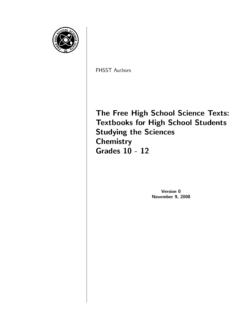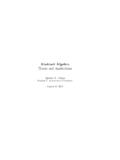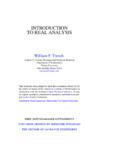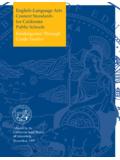Transcription of COMMON CORE STATE STANDARDS - Michigan
1 COMMON core STATE STANDARDS FOR English Language Arts and Literacy in History/Social Studies & Science Table of Contents K 5 STANDARDS for English Language Arts and Literacy in History/Social Studies & College and Career Readiness STANDARDS for Reading STANDARDS for Literature K Reading STANDARDS for Informational Text K STANDARDS for Reading: Foundational Skills (K 3)..12 Text College and Career Readiness STANDARDS for Writing STANDARDS K College and Career Readiness STANDARDS for Speaking and Speaking and Listening STANDARDS K College and Career Readiness STANDARDS for Language STANDARDS K English Language Arts Conventions Progressive Skills texts Illustrating the Complexity, Quality.
2 And Range of Student Reading K Staying on Topic Within a Grade and Across 6 12 STANDARDS for English Language College and Career Readiness STANDARDS for Reading STANDARDS for Literature 6 Reading STANDARDS for Informational Text 6 Text College and Career Readiness STANDARDS for Writing STANDARDS 6 College and Career Readiness STANDARDS for Speaking and Speaking and Listening STANDARDS 6 College and Career Readiness STANDARDS for Language STANDARDS 6 English Language Arts Conventions Progressive Skills texts Illustrating the Complexity, Quality, and Range of Student Reading 6 6 12 STANDARDS for Literacy in History/Social Studies & College and Career Readiness STANDARDS for Reading STANDARDS for History/Social Studies 6 Reading STANDARDS for Science 6 College and Career Readiness STANDARDS for Writing STANDARDS for History/Social Studies & Science 6 STANDARDS for English Language Arts and Literacy in History/Social Studies & Science | Introduction 1 Introduction The COMMON core STATE STANDARDS for English Language Arts and Literacy in History/Social Studies and Science are the culmination of an extended.
3 Broad-based effort to fulfill the charge issued by the states to create the next generation of K 12 STANDARDS that help ensure that all students are college and career ready in literacy by no later than the end of high school . The STANDARDS set requirements for English language arts (ELA) but also for reading, writing, speaking, listening, and language in the social and natural sciences . Just as students must learn to communicate effectively in a variety of content areas, so too must the STANDARDS specify the literacy skills and understandings required for eventual college and career readiness in history, social studies, and science as well as ELA.
4 By their structure, the STANDARDS encourage curriculum makers to take a comprehensive approach that coordinates ELA courses with courses in other subject areas in order to help students acquire a wide range of ever more sophisticated knowledge and skills through reading, writing, speaking, and listening. The present work, led by the Council of Chief STATE school Officers (CCSSO) and the National Governors Association (NGA), builds on the foundation laid by states in their decades-long work on crafting high -quality education STANDARDS , including their work on the American Diploma Project with Achieve. The STANDARDS also draw on the most important international models as well as research and input from numerous sources, including scholars, assessment developers, professional organizations, and educators from kindergarten through college.
5 In their design and content, the STANDARDS represent a synthesis of the best elements of STANDARDS -related work to date and an important advance over that previous work. As specified by CCSSO and NGA, the STANDARDS are (1) research and evidence based, (2) aligned with college and work expectations, (3) rigorous, and (4) internationally benchmarked. A particular standard was included in the document only when the best available evidence indicated that its mastery was essential for students to be college and career ready in a twenty-first-century, globally competitive society. As new and better evidence emerges, the STANDARDS will be revised accordingly.
6 The STANDARDS are an extension of a prior initiative led by CCSSO and NGA to develop College and Career Readiness (CCR) STANDARDS in reading, writing, speaking, listening, and language as well as in mathematics. The CCR Reading, Writing, and Speaking and Listening STANDARDS , released in draft form in September 2009, serve, in revised form, as the backbone of the present document. Consistent across grades and disciplines, the CCR STANDARDS create an essential unity within the document and a consistent point of reference for educators. Whether guiding third graders through a science unit or high school sophomores through a classic work of literature, teachers can look to the same CCR STANDARDS included in each section of this document to help judge whether students are on course for being college and career ready.
7 Grade-specific K 12 STANDARDS in reading, writing, speaking, listening, and language translate the broad (and, for the earliest grades, seemingly distant) aims of the CCR STANDARDS into age- and attainment-appropriate terms. While college and career readiness is the end point of the STANDARDS an ambitious goal in its own right some students will reach that point before the end of high school . For those students who do complete the STANDARDS requirements before graduation, advanced work in such areas as literature, composition, language, and journalism should be available. It is beyond the scope of the STANDARDS to describe what such advanced work should consist of, but it should provide the next logical step up from the college and career readiness baseline established here.
8 As a natural outgrowth of meeting the charge to define college and career readiness, the STANDARDS also lay out a vision of what it means to be a literate person in the twenty-first century. Indeed, the skills and understandings students are expected to demonstrate have wide applicability outside the classroom or workplace. Students who meet the STANDARDS readily undertake the close, attentive reading that is at the heart of understanding and enjoying complex works of literature. They habitually perform the critical reading necessary to pick carefully through the staggering amount of information available today in print and online.
9 They actively seek the wide, deep, and thoughtful engagement with high -quality literary and informational texts that builds knowledge, enlarges experience, and broadens worldviews. They reflexively demonstrate the cogent reasoning and use of evidence that is essential to both private deliberation and responsible citizenship in a democratic republic. In short, students who master the STANDARDS develop the skills in reading, writing, speaking, and listening that are the foundation for any creative and purposeful expression in language. March 2010 STANDARDS for English Language Arts and Literacy in History/Social Studies & Science | Introduction 2 Key Design Considerations A focus on results rather than means By focusing on required achievements, the STANDARDS leave room for teachers, curriculum developers, and states to determine how those goals should be reached and what additional topics should be addressed.
10 Thus, the STANDARDS do not mandate such things as a particular writing process or specify the full range of metacognitive strategies that students may need to use to monitor and direct their thinking and learning. Teachers are thus free to provide students with whatever tools and knowledge their professional judgment and experience identify as most helpful for meeting the goals set out in the STANDARDS . An integrated model of literacy Although the STANDARDS are divided into Reading, Writing, Speaking and Listening, and Language strands for conceptual clarity, the processes of communication are closely connected, as reflected throughout this document.


















